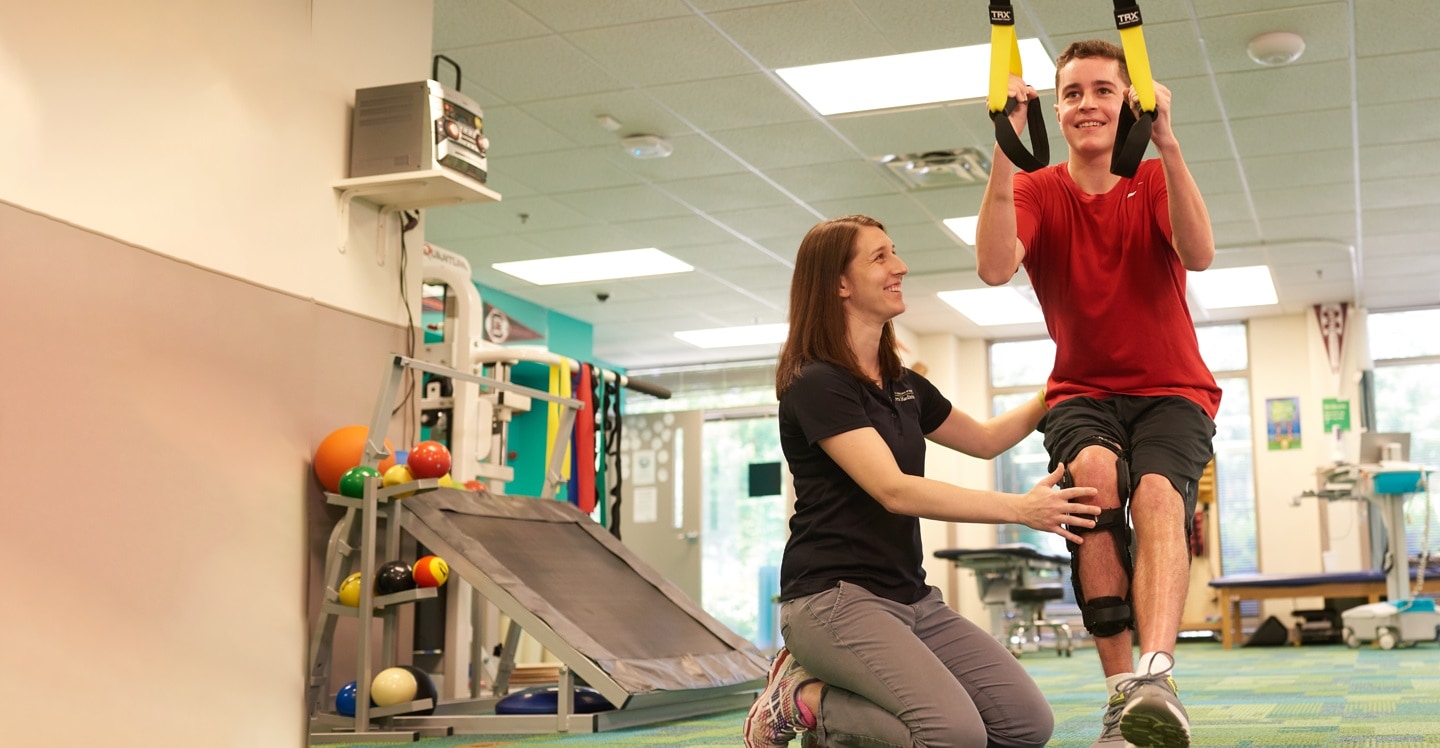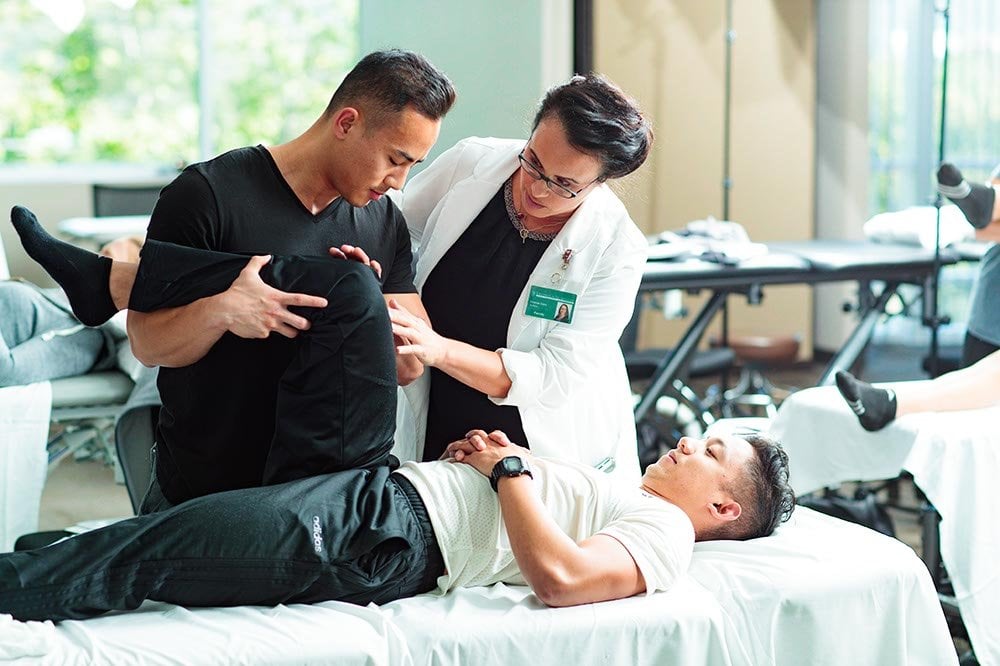To become a sports physical therapist, you need to complete a bachelor’s degree, followed by a Doctor of Physical Therapy (DPT) program, and obtain the necessary licenses and certifications. Sports physical therapists specialize in treating athletes and helping them recover from injuries, improve performance, and prevent future injuries.
With a growing demand for healthcare professionals in the sports industry, pursuing a career as a sports physical therapist can be rewarding and fulfilling. We will explore the educational requirements, skills, and steps to become a sports physical therapist, as well as the potential career opportunities and salary prospects in this field.
So, if you have a passion for sports and a strong interest in rehabilitation, let’s dive into the exciting world of sports physical therapy.

Credit: www.choa.org
2. Educational Requirements
Becoming a sports physical therapist requires a solid educational foundation. It is essential to complete a series of educational milestones to gain the knowledge and skills necessary for this rewarding career path. The educational requirements for sports physical therapists typically include obtaining a bachelor’s degree, earning a doctor of physical therapy (DPT) degree, and gaining clinical experience through internships. Let’s delve into each requirement in detail.
2.1 Bachelor’s Degree in Related Field
The first step in pursuing a career as a sports physical therapist is to obtain a bachelor’s degree in a related field. While there is no specific undergraduate major required, it is advisable to choose a program that offers coursework in areas such as biology, anatomy, physiology, kinesiology, and exercise science. These courses provide a strong foundation in the sciences and help develop a comprehensive understanding of the human body and its movement. Graduating with a bachelor’s degree sets the groundwork for further academic pursuits in the field of physical therapy.
2.2 Doctor of Physical Therapy (dpt) Degree
After completing a bachelor’s degree, aspiring sports physical therapists must pursue a Doctor of Physical Therapy (DPT) degree. This professional program typically takes three years to complete and focuses on extensive coursework and hands-on clinical training. It provides students with the advanced knowledge and skills necessary to evaluate, diagnose, and treat a wide range of musculoskeletal injuries and conditions. Some areas of study during a DPT program include therapeutic exercise, manual therapy techniques, biomechanics, and sports rehabilitation protocols. Earning a DPT degree is crucial for individuals who aspire to work as sports physical therapists.
2.3 Clinical Experience and Internships
In addition to academic coursework, gaining clinical experience and internships plays a vital role in preparing students to become sports physical therapists. These hands-on experiences provide opportunities to work directly with patients under the supervision of licensed professionals. Through clinical rotations in different healthcare settings, students develop their assessment and treatment skills while gaining exposure to various sports-related injuries. Internships offer valuable networking opportunities and allow students to apply theoretical knowledge in real-world scenarios, honing their clinical decision-making abilities. The combination of academic knowledge and practical experience is essential in preparing individuals for a successful career as a sports physical therapist.

Credit: www.nextfitclubs.com
3. Developing Essential Skills
Becoming a sports physical therapist requires the development of essential skills that are specifically tailored to the field of sports medicine. These skills will not only enhance the knowledge and expertise of the therapist but also enable them to provide effective treatment and rehabilitation for athletes and sports enthusiasts. In this section, we will explore the three key skills that are crucial for aspiring sports physical therapists.
3.1 Knowledge of Sports Medicine
Having a solid foundation in sports medicine is vital for a sports physical therapist. This includes a deep understanding of the physiology, anatomy, and biomechanics of the human body, particularly in relation to athletic performance and injuries. A therapist with a strong knowledge of sports medicine can accurately diagnose and assess sports-related injuries, as well as design tailored treatment plans for athletes.
3.2 Manual Therapy Techniques
Manual therapy techniques are an integral part of a sports physical therapist’s skill set. These techniques involve the skilled manipulation of soft tissues, joints, and muscles to reduce pain, improve flexibility, and promote healing. Some commonly used manual therapy techniques include massage, joint mobilization, and myofascial release. By mastering these techniques, a sports physical therapist can effectively address musculoskeletal issues and help athletes recover faster.
3.3 Therapeutic Exercise Prescription
Therapeutic exercise prescription is another essential skill for a sports physical therapist. This involves tailoring exercise programs to target specific areas of weakness or imbalances in an athlete’s body. These exercises are designed to improve strength, stability, flexibility, and overall performance. A sports physical therapist must have knowledge of various exercise techniques and their applications, ensuring they can provide athletes with safe and effective exercises that aid in their recovery and enhance their performance.
4. Gaining Practical Experience
4. Gaining Practical Experience
Building practical experience is crucial for aspiring sports physical therapists. It helps them develop the necessary skills, knowledge, and confidence to work with athletes and sports teams. There are several avenues to gain practical experience that can set you apart in this competitive field.
4.1 Volunteering with Sports Teams or Athletic Programs
One way to gain practical experience is by volunteering with sports teams or athletic programs. By doing so, you will have the opportunity to work closely with athletes and observe how injuries are managed and rehabilitated. Moreover, volunteering also allows you to develop relationships with athletes, coaches, and fellow medical professionals, which can be invaluable for future career opportunities.
4.2 Job Shadowing or Observing Experienced Sports Physical Therapists
Job shadowing or observing experienced sports physical therapists is another effective method to gain practical experience. This hands-on approach allows you to witness the day-to-day operations of a sports physical therapy practice. By shadowing professionals in the field, you can observe their assessment techniques, treatment modalities, and how they interact with patients. This experience provides valuable insights into the practical skills and knowledge required to excel as a sports physical therapist.
Participating in research studies or presentations can further enhance your practical experience as a sports physical therapist. This involvement enables you to contribute to the field by conducting studies or presenting research findings. Additionally, it allows you to stay updated on the latest advancements and techniques in sports physical therapy.
TABLE:
| Ways to Gain Practical Experience |
|---|
| Volunteering with Sports Teams or Athletic Programs |
| Job Shadowing or Observing Experienced Sports Physical Therapists |
| Participating in Research Studies or Presentations |
To become a skilled sports physical therapist, practical experience is key. By volunteering, job shadowing, or participating in research studies, you can acquire the necessary skills, knowledge, and connections to thrive in this field. It’s essential to actively seek out opportunities that will provide hands-on experiences and allow you to apply what you’ve learned in a real-world setting.
5. Obtaining Licensure and Certification
Obtaining licensure and certification is a crucial step in becoming a sports physical therapist. It not only ensures that you meet the required standards of competency but also signifies your commitment to the profession. Let’s explore the two important aspects of this process: state licensure and specialty certification in sports physical therapy.
5.1 State Licensure as a Physical Therapist
To practice as a physical therapist, you need to obtain state licensure. This process varies from state to state, but it generally includes a combination of education, examination, and documentation of clinical experience. Here are the basic steps you need to follow:
- Graduate from an accredited physical therapy program.
- Pass the National Physical Therapy Examination (NPTE) administered by the Federation of State Boards of Physical Therapy (FSBPT).
- Complete any additional state-specific requirements, which may include jurisprudence exams or background checks.
- Submit an application along with the necessary documents and fees to the state licensing board.
Once you have successfully obtained your state license, you can legally practice as a physical therapist in that particular state. Remember to keep your license up to date by renewing it according to the specific renewal requirements of your state.
5.2 Specialty Certification in Sports Physical Therapy
While state licensure allows you to practice as a general physical therapist, obtaining specialty certification in sports physical therapy can enhance your credibility and open up opportunities in the field of sports medicine. The American Board of Physical Therapy Specialties (ABPTS) offers a specialist certification in sports physical therapy. Here’s how you can pursue this certification:
- Gain the required clinical experience in sports physical therapy, which typically involves working with athletes under the guidance of a certified sports physical therapist.
- Attend continuing education courses and workshops focused on sports-related topics to broaden your knowledge and skills in this specialized area.
- Apply for the Sports Certified Specialist (SCS) examination, which is administered by the ABPTS. This exam evaluates your expertise and competence in sports physical therapy.
- Pass the SCS examination to earn your specialist certification in sports physical therapy from the ABPTS.
Becoming a sports physical therapist is a rewarding journey that requires dedication and continuous professional development. By obtaining both state licensure and specialty certification in sports physical therapy, you can position yourself as a knowledgeable and skilled professional ready to make a positive impact in the world of sports medicine.
6. Ongoing Professional Development
Ongoing professional development plays a crucial role in becoming a sports physical therapist. By continuously enhancing your skills and knowledge, you can stay updated with the latest advancements in the field and provide effective treatment to athletes.
Continuing education and advanced coursesContinuing education is a vital aspect of a sports physical therapist’s career. To stay ahead in this constantly evolving field, therapists must actively seek out opportunities for ongoing learning and skill development. Attending advanced courses and workshops allows you to refine and expand your knowledge in specific areas of sports rehabilitation. These courses cover topics like advanced manual therapy techniques, specialized exercise protocols, and the latest advancements in injury prevention and treatment. By investing in continuing education, you demonstrate your commitment to providing the best possible care to your patients and position yourself as a respected expert in your field. Networking and professional organizations
Networking and joining professional organizations are essential for sports physical therapists looking to stay connected and up-to-date with industry trends. By actively participating in professional events, conferences, and workshops, you can establish valuable connections with other professionals in the field. These connections offer opportunities for collaboration, mentorship, and sharing of knowledge and best practices. Additionally, becoming a member of professional organizations such as the American Physical Therapy Association (APTA) provides access to resources, publications, and forums where you can further enhance your skills and stay informed about current research and advancements in sports physical therapy. Keeping up with the latest research and techniques
In the ever-evolving field of sports physical therapy, it’s crucial to stay abreast of the latest research and techniques. Keeping up with advancements allows you to provide the most effective and evidence-based care to your athletes. Regularly reviewing scientific literature, subscribing to reputable journals, and attending conferences dedicated to sports medicine will keep you informed about emerging trends and cutting-edge treatments. It’s also vital to stay connected with academia and work closely with researchers to bridge the gap between theory and practice. By incorporating the latest research findings into your treatment plans, you can enhance patient outcomes and solidify your reputation as a knowledgeable and progressive sports physical therapist. To summarize, ongoing professional development is paramount for sports physical therapists who strive to deliver optimal care for their patients. By continuously enriching your knowledge through continuing education, networking with industry peers, and staying updated with the latest research and techniques, you position yourself as a trusted expert in the field and ensure that you are equipped to provide the best care possible for athletes at all levels of competition.

Credit: www.usa.edu
Conclusion
Becoming a sports physical therapist requires a combination of passion, dedication, and education. By following the necessary steps, you can embark on a fulfilling career helping athletes recover from injuries and reach their peak performance. From obtaining a bachelor’s degree in a related field to pursuing a Doctor of Physical Therapy, the journey may be challenging, but the rewards are immeasurable.
Embrace the opportunities, stay updated with the latest advancements, and keep honing your skills to excel in this competitive field. Start your journey today and make a positive impact in the world of sports medicine.




